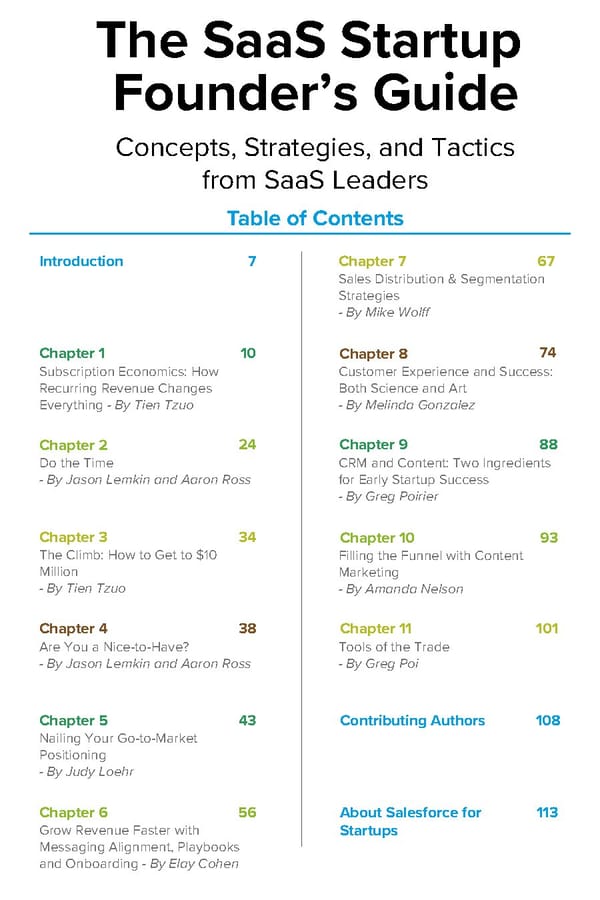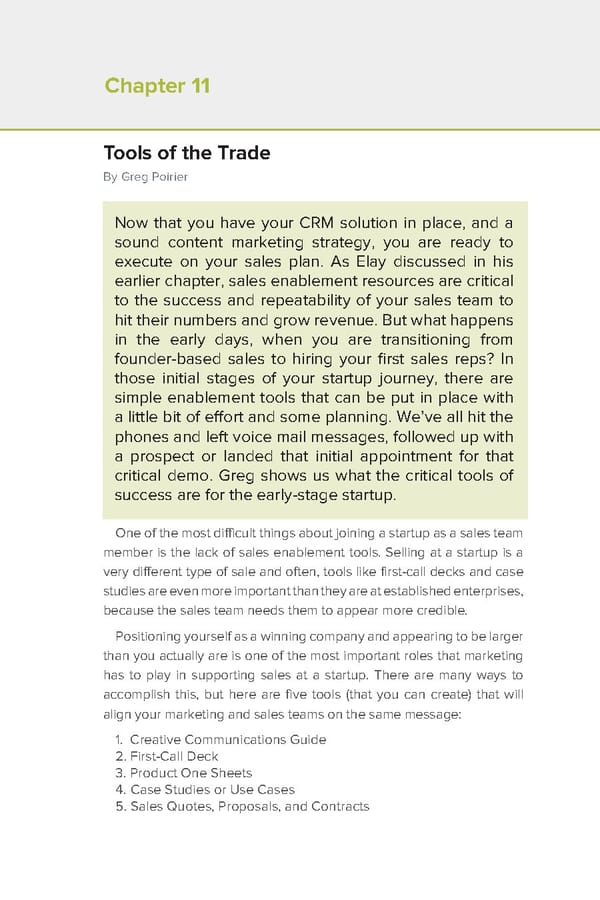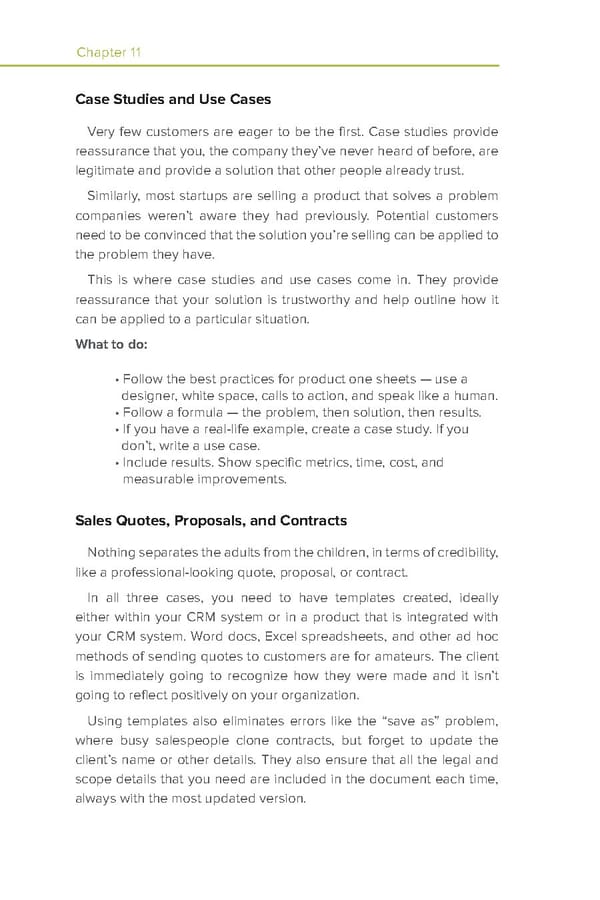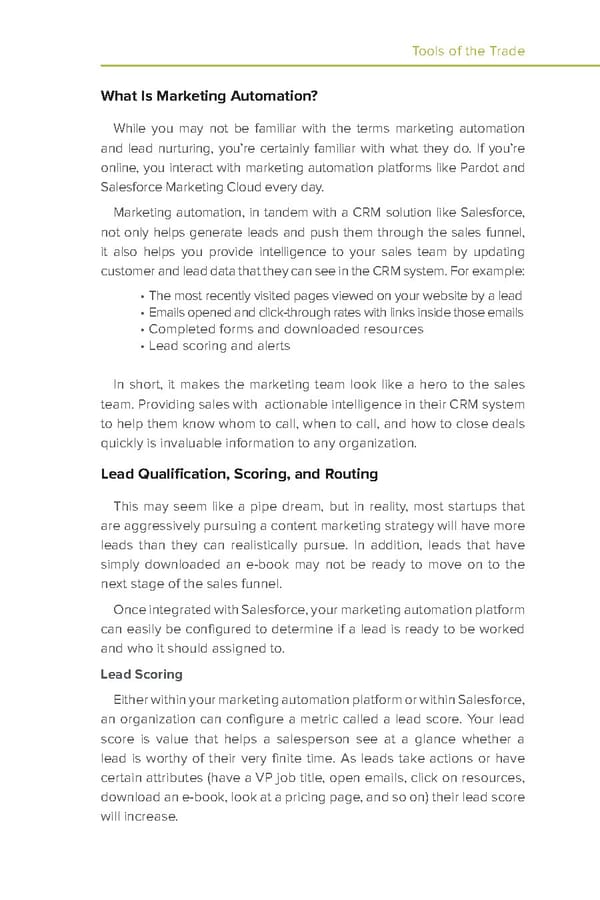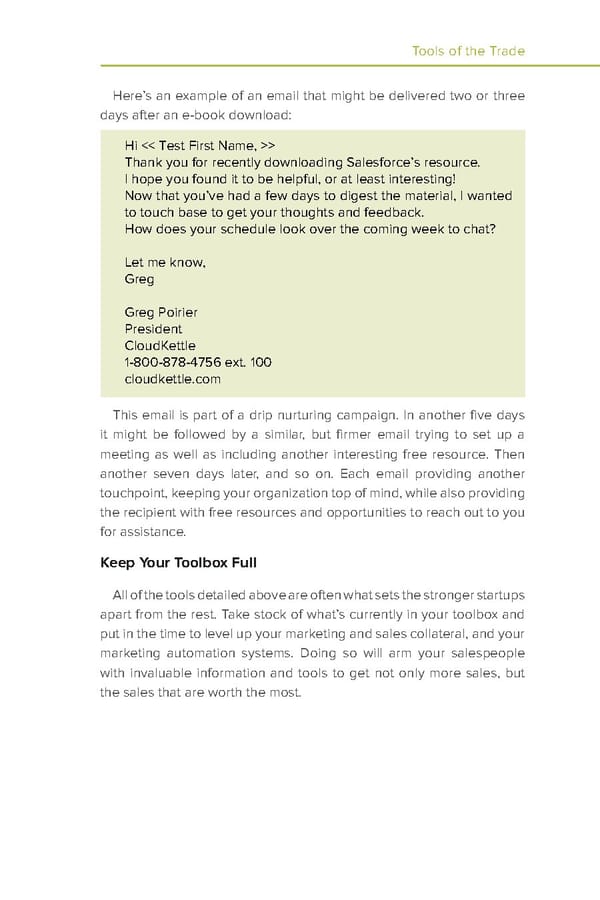Tools of the Trade
By Greg Poirier, CEO, CloudKettle
The SaaS Startup Founder’s Guide Concepts, Strategies, and Tactics from SaaS Leaders Table of Contents Introduction 7 Chapter 7 67 Sales Distribution & Segmentation Strategies - By Mike Wolff Chapter 1 10 Chapter 8 74 Subscription Economics: How Customer Experience and Success: Recurring Revenue Changes Both Science and Art Everything - By Tien Tzuo - By Melinda Gonzalez Chapter 2 24 Chapter 9 88 Do the Time CRM and Content: Two Ingredients - By Jason Lemkin and Aaron Ross for Early Startup Success - By Greg Poirier Chapter 3 34 Chapter 10 93 The Climb: How to Get to $10 Filling the Funnel with Content Million Marketing - By Tien Tzuo - By Amanda Nelson Chapter 4 38 Chapter 11 101 Are You a Nice-to-Have? Tools of the Trade - By Jason Lemkin and Aaron Ross - By Greg Poi Chapter 5 43 Contributing Authors 108 Nailing Your Go-to-Market Positioning - By Judy Loehr Chapter 6 56 About Salesforce for 113 Grow Revenue Faster with Startups Messaging Alignment, Playbooks and Onboarding - By Elay Cohen

Chapter 10 Filling the Funnel with Content Marketing Chapter 11 Tools of the Trade By Greg Poirier Now that you have your CRM solution in place, and a sound content marketing strategy, you are ready to execute on your sales plan. As Elay discussed in his earlier chapter, sales enablement resources are critical to the success and repeatability of your sales team to hit their numbers and grow revenue. But what happens in the early days, when you are transitioning from founder-based sales to hiring your first sales reps? In those initial stages of your startup journey, there are simple enablement tools that can be put in place with a little bit of effort and some planning. We’ve all hit the phones and left voice mail messages, followed up with a prospect or landed that initial appointment for that critical demo. Greg shows us what the critical tools of success are for the early-stage startup. One of the most difficult things about joining a startup as a sales team member is the lack of sales enablement tools. Selling at a startup is a very different type of sale and often, tools like first-call decks and case studies are even more important than they are at established enterprises, because the sales team needs them to appear more credible. Positioning yourself as a winning company and appearing to be larger than you actually are is one of the most important roles that marketing has to play in supporting sales at a startup. There are many ways to accomplish this, but here are five tools (that you can create) that will align your marketing and sales teams on the same message: 1. Creative Communications Guide 2. First-Call Deck 3. Product One Sheets 4. Case Studies or Use Cases 5. Sales Quotes, Proposals, and Contracts
Chapter 11 Tools of the Trade The Sales-Enablement Tools All Startups Need The Creative Communications Guide This should be a short document, ideally less than three pages that are shared somewhere like Chatter, where all employees have easy access. It should include your company’s official font, hex values for official colors, writing style, voice and tone guidelines, and finally, a boilerplate paragraph that describes the organization. One simple, easy-to-find resource for any employee to access. If it’s long or difficult to use, people simply won’t refer to it. First-Call Deck One common mistake that startups make is to assume that their pitch deck can be repurposed as a first-call deck for sales. Now, if it already has a great- looking template, that part can be recycled, but the content isn’t as transferrable. There’s a science to first-call decks and one of the keys is to keep them short. The instinct for most people is to create something that is 20–30 slides long and spend the first five slides talking about how great you are. The truth is that you might only have a 20-minute window of attention (regardless of how long the meeting or call is booked for), so you need to cover your most critical items in that period. Create something that is 8–12 slides long, with your font size at 30-point or more, and focus on using imagery rather than many lines of copy. What to include: • Cover • Agenda • Where we are today • The problem • How we solve the problem • What makes us different • Final slide with contact information The key is to focus on explaining why the customer might be feeling pain, even if they aren’t aware of it. Remember, when you sell, you will most likely have to sell the potential customer that the pain point is actually there, and that they need to find a solution. Only then can you sell the solution you have to solve their pain. If people aren’t aware they have a headache, they won’t buy painkillers.
Chapter 11 Tools of the Trade Other Tips Get to the point, no one wants your life story. Rather than talking about how shiny you are, focus on communicating why the potential client has a problem, how that problem can be solved, and wrap that in stories that will resonate with your audience. Also, focus on asking questions. Think of this as an early-stage date — no one likes the person who spends the whole evening talking about how great they are. They want someone to ask questions about them. Product One Sheets Product one sheets are the necessary evil of the sales collateral world. They aren’t read often, they aren’t particularly interesting, but they’re still required. Why? Primarily because today’s sales cycle has become much more complex and inclusive. More employees at each company are involved in decision-making when it comes to purchases, and that means you need material that can be passed around. One sheets should be easily downloaded, easily found on your website, easily understood by a person not familiar with your organization, and easily shared by a sales team member. What to do: • Be strategic. Solve a problem, not all the problems. • Be creative. Have a great headline and be interesting. • Include your value proposition. Why should the customer buy? • Speak like a person. Eliminate jargon and industry speak. • Design with purpose. Use a strong headline, headers, and original images. • Pay a designer. Have a template built that you can use for all product one sheets. • Include a testimonial. Use a real customer and make their quote front and center. • Include a call to action. Ensure there are multiple ways to contact your company, including by phone, email, and social media. • Use white space. Do not fill every inch with copy.
Chapter 11 Tools of the Trade Case Studies and Use Cases Very few customers are eager to be the first. Case studies provide reassurance that you, the company they’ve never heard of before, are legitimate and provide a solution that other people already trust. Similarly, most startups are selling a product that solves a problem companies weren’t aware they had previously. Potential customers need to be convinced that the solution you’re selling can be applied to the problem they have. This is where case studies and use cases come in. They provide reassurance that your solution is trustworthy and help outline how it can be applied to a particular situation. What to do: • Follow the best practices for product one sheets — use a designer, white space, calls to action, and speak like a human. • Follow a formula — the problem, then solution, then results. • If you have a real-life example, create a case study. If you don’t, write a use case. • Include results. Show specific metrics, time, cost, and measurable improvements. Sales Quotes, Proposals, and Contracts Nothing separates the adults from the children, in terms of credibility, like a professional-looking quote, proposal, or contract. In all three cases, you need to have templates created, ideally either within your CRM system or in a product that is integrated with your CRM system. Word docs, Excel spreadsheets, and other ad hoc methods of sending quotes to customers are for amateurs. The client is immediately going to recognize how they were made and it isn’t going to reflect positively on your organization. Using templates also eliminates errors like the “save as” problem, where busy salespeople clone contracts, but forget to update the client’s name or other details. They also ensure that all the legal and scope details that you need are included in the document each time, always with the most updated version.
Chapter 11 Tools of the Trade What Is Marketing Automation? While you may not be familiar with the terms marketing automation and lead nurturing, you’re certainly familiar with what they do. If you’re online, you interact with marketing automation platforms like Pardot and Salesforce Marketing Cloud every day. Marketing automation, in tandem with a CRM solution like Salesforce, not only helps generate leads and push them through the sales funnel, it also helps you provide intelligence to your sales team by updating customer and lead data that they can see in the CRM system. For example: • The most recently visited pages viewed on your website by a lead • Emails opened and click-through rates with links inside those emails • Completed forms and downloaded resources • Lead scoring and alerts In short, it makes the marketing team look like a hero to the sales team. Providing sales with actionable intelligence in their CRM system to help them know whom to call, when to call, and how to close deals quickly is invaluable information to any organization. Lead Qualification, Scoring, and Routing This may seem like a pipe dream, but in reality, most startups that are aggressively pursuing a content marketing strategy will have more leads than they can realistically pursue. In addition, leads that have simply downloaded an e-book may not be ready to move on to the next stage of the sales funnel. Once integrated with Salesforce, your marketing automation platform can easily be configured to determine if a lead is ready to be worked and who it should assigned to. Lead Scoring Either within your marketing automation platform or within Salesforce, an organization can configure a metric called a lead score. Your lead score is value that helps a salesperson see at a glance whether a lead is worthy of their very finite time. As leads take actions or have certain attributes (have a VP job title, open emails, click on resources, download an e-book, look at a pricing page, and so on) their lead score will increase.
Chapter 11 Tools of the Trade Determining what leads to work each morning has historically been a very subjective process. Salespeople rely on gut, or worse, work leads in the order they see them arrive in lead queue. Lead scoring provides the ability for your organization and your salespeople to prioritize what leads to work, and then in combination with lead routing and lead nurturing, determine how they should be worked. Only have an email address and no job title? That lead is less valuable — it should be nurtured by marketing automation until it’s more mature. Have a hot lead where the CEO of a large enterprise has looked at your pricing page? Lead scoring and routing will ensure that it lands on top of the heap for your best salesperson. In short, salespeople can leave low-value leads to marketing automation, freeing up their time to focus on those most likely to turn into revenue most quickly. Sales can begin their day by reviewing a hot list of which leads are most likely to convert instead of guessing which to invest time in. Lead Routing Once a lead score is in place, leads can easily be routed in your CRM system. The rules that determine where a lead should be sent can be built to examine the lead score and to follow your organization’s territories or industry sales patches. For example, a score below 50 could be left in a queue for marketing automation to work. One that was over 50, from the automotive industry, and in the United States could be sent to the sales rep. While an almost identical lead that was from Britain could instead be sent to your European channel partner. Lead Nurturing Lead nurturing helps solve the problem of warming the leads that aren’t ready for sales to pursue. Leads are valuable, and just because their information is incomplete or they aren’t ready to be pursued by the sales team doesn’t mean you can afford to ignore them. Lead nurturing allows startups with very finite human resources to seem much bigger than they are. The most obvious application is to send automated warming emails to a lead after they download a resource. Their lead score is too low to justify having a human pursue them, but with no effort, you can have those leads receive regular emails that appear to be from a sales rep, staying in touch, keeping your organization top of mind.
Chapter 11 Tools of the Trade Here’s an example of an email that might be delivered two or three days after an e-book download: Hi << Test First Name, >> Thank you for recently downloading Salesforce’s resource. I hope you found it to be helpful, or at least interesting! Now that you’ve had a few days to digest the material, I wanted to touch base to get your thoughts and feedback. How does your schedule look over the coming week to chat? Let me know, Greg Greg Poirier President CloudKettle 1-800-878-4756 ext. 100 cloudkettle.com This email is part of a drip nurturing campaign. In another five days it might be followed by a similar, but firmer email trying to set up a meeting as well as including another interesting free resource. Then another seven days later, and so on. Each email providing another touchpoint, keeping your organization top of mind, while also providing the recipient with free resources and opportunities to reach out to you for assistance. Keep Your Toolbox Full All of the tools detailed above are often what sets the stronger startups apart from the rest. Take stock of what’s currently in your toolbox and put in the time to level up your marketing and sales collateral, and your marketing automation systems. Doing so will arm your salespeople with invaluable information and tools to get not only more sales, but the sales that are worth the most.

